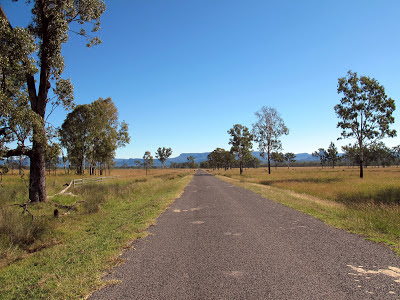 |
| Dawson River |
 |
| Road into Carnarvon Gorge National Park |
 |
| Cattle on the road to Carnarvon. |
 |
| Metal Road into Carnarvon National Park |
 |
| Approaching the Carnarvon Gorge |
 |
| Ford across metal road into Carnarvon |
 |
| Takarakka Bush Resort, Carnarvon National Park |
 |
| Safari tent, Carnarvon National Park |
There's no shortage of tents of various sizes and styles in our house yet, after our last trip a few months ago, we went and bought another one! This one came with the assurance that it could be erected in a minute. Yes! We achieved that goal and it was soon set up with the dining table and storage cupboard that make our camp comfortable for multiple night stays.
With our camp now set up, we went off to explore the campground, climbing the hill to the look out.
| From Takarakka Bush Resort Lookout. |
The campground was far from full however, one afternoon, screams of enjoyment, splashing and excited voices came from the river behind our campsite. I went to investigate and found about fifty students having a great time in the river. Year 7 students from Caloundra, they were on their final primary school camp and had arrived that afternoon. They had set up their tents in a circle in a different area and were having a great time! In the days to come, we met them as they explored the park and gathered memories that I am sure will last a lifetime.
 |
| River Walk, Carnarvon National Park |
 |
| Carnarvon Creek |
 |
| Carnarvon |
Following our pleasant walk, we consumed our lunch under the bored gaze of the local kangaroos. Map on the table, we looked at the longer signposted walks to choose one for the next day. With enticing names such as Cathedral Cave, Aljion Falls Moss Garden Baloon Cave, Art Gallery with its famous aboriginal drawings, Boolimba Bluff with its sandstone caves and ladders up the cliff face it was difficult to choose!

Gorgeous photos and story. What a trip.
ReplyDelete